Turkish Journal of Hematology Volume: 33 - Issue: 4
Create successful ePaper yourself
Turn your PDF publications into a flip-book with our unique Google optimized e-Paper software.
Turk J Hematol 2016;<strong>33</strong>:326-<strong>33</strong>0<br />
Baytan B, et al: Emotional Status and Health Quality in Childhood ALL<br />
Table 4. Mean scores <strong>of</strong> depression, anxiety, quality <strong>of</strong> life, and self-image regarding period after acute lymphocytic leukemia<br />
treatment.<br />
Period after ALL Treatment TPHS STS TSPH KCDI SAI TAI OSIQ<br />
Mean<br />
2-5 years SD<br />
n=12<br />
Mean<br />
6-9 years SD<br />
n=24<br />
Mean<br />
10 and more years SD<br />
n=14<br />
64.58<br />
15.10<br />
81.<strong>33</strong><br />
16.72<br />
87.78<br />
8.88<br />
67.<strong>33</strong><br />
14.74<br />
83.08<br />
11.34<br />
86.14<br />
8.31<br />
68.91<br />
4.63<br />
81.<strong>33</strong><br />
11.88<br />
86.07<br />
9.26<br />
36<br />
5.66<br />
28.75<br />
4.96<br />
51.50<br />
5.14<br />
52.08<br />
8.19<br />
52.500<br />
20.94<br />
52.54<br />
5.54<br />
232.25<br />
41.01<br />
234.79<br />
44.91<br />
ALL: Acute lymphocytic leukemia, SD: standard deviation, TPHS: total physical health score, TSPH: total score <strong>of</strong> psychosocial health, STS: scale total score, KCDI: Kovacs Children’s<br />
Depression Inventory, SAI: State Anxiety Inventory, TAI: Trait Anxiety Inventory, OSIQ: Offer Self-Image Questionnaire.<br />
25.42<br />
2.31<br />
48.43<br />
6.81<br />
50<br />
4.71<br />
249<br />
65.29<br />
Table 5. Comparison <strong>of</strong> the depression, anxiety, quality <strong>of</strong><br />
life, and self-image scores regarding period after acute<br />
lymphocytic leukemia treatment.<br />
Source<br />
TPHS between<br />
groups<br />
Sum <strong>of</strong><br />
Squares<br />
loneliness. For a child, quality <strong>of</strong> life is likely to be compromised<br />
by the pain <strong>of</strong> the illness and treatment, lack <strong>of</strong> energy to<br />
enjoy everyday activities, and fears about the future [18]. After<br />
cancer treatment, we usually observe that children do not<br />
want to attend to school again. Parents also usually have fears<br />
about their children contracting infections in school. The idea<br />
that their children are still vulnerable might be the reason for<br />
social isolation (according to our interviews with parents, ALL<br />
survivors are rarely allowed to join social activities outside the<br />
home), which might affect children’s quality <strong>of</strong> life negatively.<br />
Self-concept findings are similar to those <strong>of</strong> other studies, such<br />
as research on self-esteem among 578 pediatric ALL survivors<br />
compared to control groups [9]. According to some other<br />
studies, adult survivors <strong>of</strong> a variety <strong>of</strong> childhood cancers were<br />
found to have significantly lower self-esteem [18,19]. However,<br />
according to Maggiolini et al. [20], long-term adolescent ALL<br />
survivors had a more positive and mature self-image compared<br />
to a healthy student group. According to our study, self-image<br />
components such as coping capacity and individual values <strong>of</strong><br />
df<br />
Mean<br />
Squares<br />
3760.91 2 1880.45 8.87 0.00*<br />
STS between groups 2680.51 2 1340.25 10.08 0.00*<br />
TSPH between<br />
groups<br />
KCDI between<br />
groups<br />
2027.70 2 1013.85 5.19 0.01*<br />
752.39 2 376.19 20.28 0.00*<br />
SAI between groups 64.42 2 32.21 5.19 0.31<br />
TAI between groups 123.42 2 61.71 1.16 0.32<br />
OSI between groups 2<strong>33</strong>6.51 2 1168.27 0.46 0.64<br />
*: p≤0.05, F: F distribution, df: degrees <strong>of</strong> freedom, TPHS: total physical health score,<br />
TSPH: total score <strong>of</strong> psychosocial health, STS: scale total score, KCDI: Kovacs Children’s<br />
Depression Inventory, SAI: State Anxiety Inventory, TAI: Trait Anxiety Inventory.<br />
F<br />
p<br />
these children were stronger when compared to their siblings.<br />
These results indicate that patients undergoing a long and<br />
difficult treatment period, as in leukemia, may be damaged<br />
in some self-image domains, but at the same time that period<br />
may improve their capacity to cope with the problems that they<br />
encounter.<br />
Psychological problems among cancer patients are commonly<br />
reported. Acute stress symptoms, anxiety, depression, panic<br />
attacks, and post-traumatic stress symptoms might be observed<br />
among cancer patients [21,22]. Myers et al. [5] reported<br />
that anxiety was a significant problem in a subpopulation<br />
<strong>of</strong> patients with ALL immediately after diagnosis, whereas<br />
depression remained a significant problem for at least 1 year.<br />
Kanellopoulos et al. [23] reported that levels <strong>of</strong> anxiety and<br />
depression remained significantly associated with poor quality<br />
<strong>of</strong> life. Although major psychiatric disturbances are not common<br />
among survivors <strong>of</strong> ALL, a few earlier studies showed that this<br />
population has increased risk for mental health and adjustment<br />
problems [24,25,26]. Some studies indicate that the period<br />
after treatment is characterized by a higher risk <strong>of</strong> psychosocial<br />
problems compared with the actual treatment period. Children<br />
and adolescents who were <strong>of</strong>f treatment reported higher levels<br />
<strong>of</strong> depression and anxiety.<br />
The quality <strong>of</strong> life is worse at the time <strong>of</strong> diagnosis [7]. The period<br />
after treatment is characterized by a higher risk <strong>of</strong> psychosocial<br />
problems compared with the actual treatment period. Children<br />
and adolescents who were <strong>of</strong>f treatment reported higher levels<br />
<strong>of</strong> depression [27,28].<br />
There are some limitations <strong>of</strong> this research. First <strong>of</strong> all, besides<br />
the siblings who were our control group, a randomized peer<br />
group should have also participated in this research. Meanwhile,<br />
the ALL survivors who participated in this research came from<br />
the local area. A more widespread participant group would give<br />
more information about results.<br />
329

















